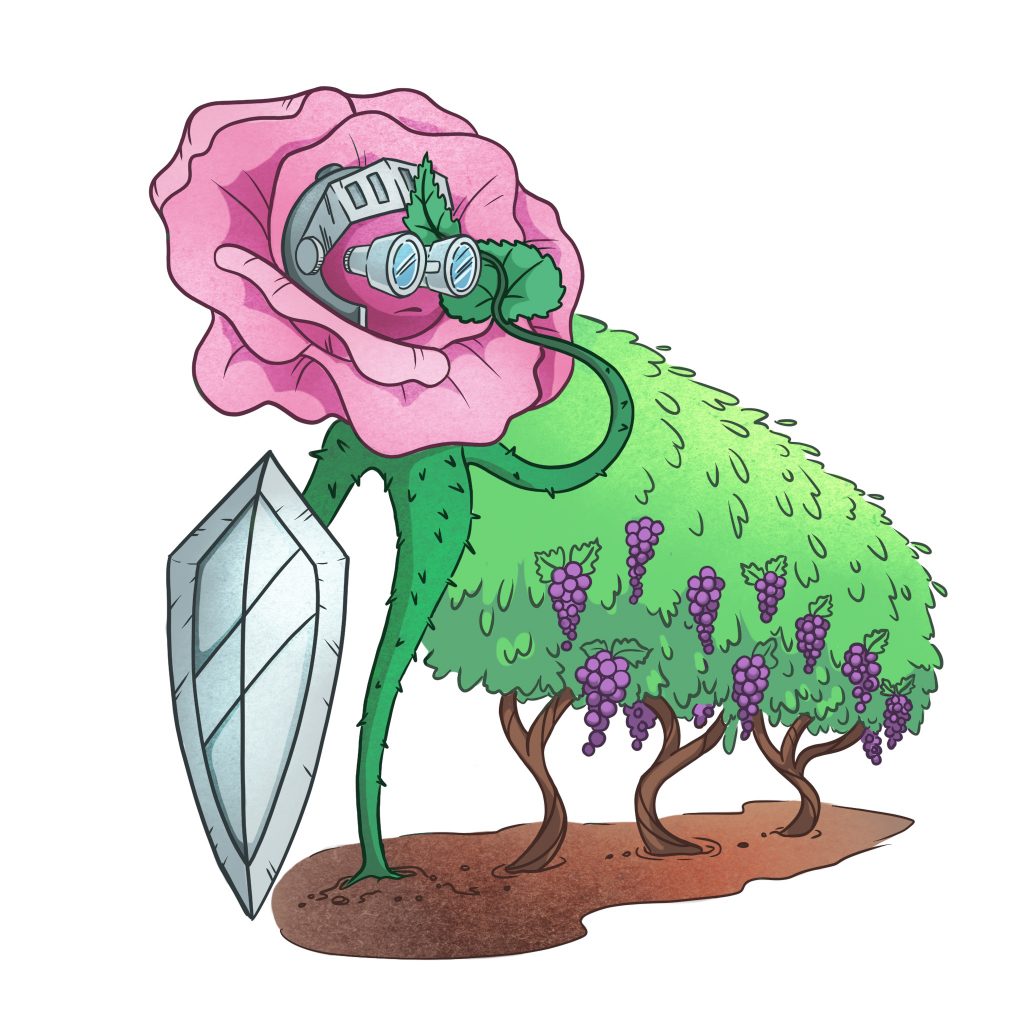
By Jenelle Patterson
As a plant molecular biologist, I often hear tales of gardening mishaps or plant-related tidbits from my friends and family.
A few years ago, a friend excitedly relayed her experience at a Niagara wine tour, where the tour guide explained that they grow rose bushes at the end of each row not only for aesthetics, but as early warning systems for pests and diseases (such as powdery mildew). This piqued my curiosity, and I discovered that using plants as biosensors or sentinels is not a modern concept. Roses have been used this way for centuries.
However, the use of roses as sentinels has disadvantages:
1) Some pests or pathogens that target grapes do not affect roses.
2) By the time a rose shows signs of a fungal infection, it may be too late to protect the grapes.
Most modern vineyards employ more sophisticated integrated pest management strategies (e.g., forecasting disease outlooks using weather reports and tracking confirmed cases). But, this canary-in-a-coal-mine approach of using plants as warning systems still may prove useful, especially where other types of testing are unavailable or costly.
ADDRESSING SENSITIVITY AND SPECIFICITY
A diverse array of agricultural and human health hazards (pathogens, heavy metals, herbicide residues, radioactivity, even explosives, to name a few) could conceivably be detected using sentinel plants. But we first need to address the reasons why roses fall short: sensitivity and specificity.
The first attempts to bioengineer sentinel plants began in the late 80s with the discovery and development of reporter genes (think of them as biological red flags). By the 90s, engineered plants were designed that could detect genotoxins (chemicals or UV-C light that cause DNA mutations). Prolonged exposure to genotoxins causes mutations in the plants, which were measured by staining the plant tissue with a chemical that turns cells blue if the reporter gene is mutated.
These plants could detect heavy metals, herbicides and radioactivity just as effectively as conventional methods that use animals or chemical analysis. And these sentinel plants were cheaper, required less maintenance and avoided the ethical concerns of using animals. Despite being a big step in the right direction, prototypes had the same issues as their natural rose counterparts: The tests took weeks to months of exposure (sensitivity) and could not be used to identify the genotoxin, only to indicate that one was present (specificity).
Bioengineering has made huge progress in the past decades as scientists develop new technologies and a better understanding of how plants naturally detect and react to changes in their environment. Plant researchers are beginning to rethink biology in terms of computer programming, adopting concepts like modular system design and logic gates.
Simply put, biological components are being treated like modular parts used to build an input/output system. Plants and all living organisms use this kind of system already. A signal is detected (e.g., getting chewed on by a bug), that information is relayed in a game of telephone by enzymes and signal molecules, generally ending in the nucleus (the control center of the cell), which flips a genetic switch to bring about some response. The power of bioengineering is the ability to design a tunable system, one that is sensitive to a specific input.
In 2011, researchers tested this principle by building a TNT-detector plant. They integrated genetic parts from bacteria into a plant’s natural stress-response pathway. Their creation could sniff out and signal the presence of soil- or airborne TNT molecules (input) by causing leaf de-greening (output), and at equivalent levels to bomb-sniffing dogs. This landmark study was just the beginning. It demonstrated the potential for bioengineered sentinel plants to address the sensitivity and specificity limitations of their natural predecessors.
RESEARCH ADVANCEMENTS
Researchers have since been identifying and redesigning biological parts to build complex logic gates. Early bioengineered systems were only capable of binary on/off states. Building more complex systems by adding modular components that work together gives the plant the ability to make more nuanced ‘decisions’ (like computer logic gates: react to this and/or this, but not to that). This can reduce false positives and allow for more sensitive detection. Different reporter outputs can also be used to reduce testing times and avoid destroying the sentinel plant, such as engineering plants to produce fluorescent proteins in their leaves, which is easily visible under a UV lamp.
Researchers still have more work to do to make sentinel plants reliable enough for routine use in agriculture. But it’s not hard to foresee a future where genetically trained roses are a critical part of modern integrated pest management, and not just a nice story to tell guests on a wine tour.









